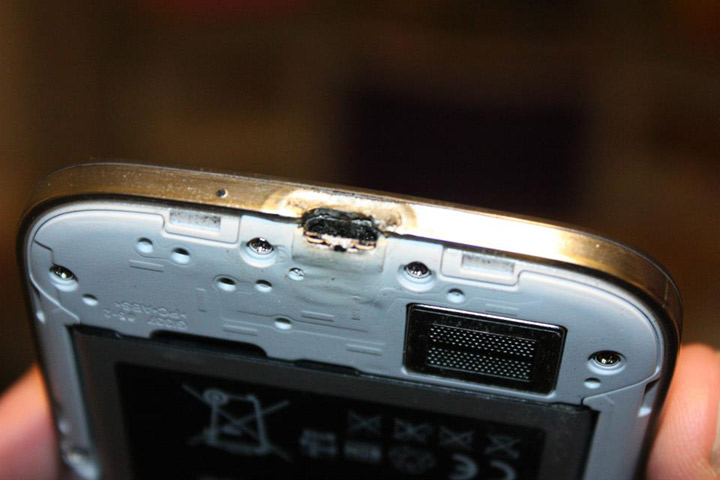TORONTO – The last thing you may consider to be a fire hazard in your home is your smartphone. But if recent events are any indication, our trusty devices may have a hidden danger – their batteries.

Guelph, Ont.-area resident Hope Casserly is the latest Canadian to go public with a story about her Samsung Ace II x smartphone’s battery exploding.
In a recent CBC “Go Public” story, Casserly recalled the night her smartphone’s battery exploded, bounced across her room and set her bedding on fire. According to the interview, the smartphone was sitting on her bedside table, not plugged in and facing screen side-up.
“Battery exploded while I was asleep waking me up with a loud popping noise,” wrote Casserly on her Facebook page in October. “Battery (given by the company) exploded and caught fire and burnt my mattress and bedding.”
According to her Facebook page, the phone was just over a year old at the time.
Global News reached out to Casserly regarding the incident, but a request for comment was not immediately returned.
This isn’t the first time that a smartphone fire has made headlines.
In February 2013, South Korean fire officials said a man suffered second-degree burns after the lithium-ion battery from a 2011 Galaxy Note phone caught fire in his pants pocket.
- Premier Moe responds to Trudeau’s ‘good luck with that’ comment
- Drumheller hoping to break record for ‘largest gathering of people dressed as dinosaurs’
- As Canada’s tax deadline nears, what happens if you don’t file your return?
- Planning a summer trip to Quebec’s Îles-de-la-Madeleine? You’ll have to pay up
Later that summer Chinese news outlets alleged that a Samsung Galaxy S4 was responsible for a house fire after a man’s phone burst into flames while he was using it.
READ MORE: Customer alleges Samsung tried to silence him after complaint
In December 2013, Vancouver-area resident Richard Wygand told Global News he woke up in the middle of the night to find his Samsung Galaxy S4 – which was plugged into its charger – smoking and producing sparks.
And earlier this year a student at a Maine-area middle school was treated for minor injuries after her iPhone 5C caught fire in her pocket.
Batteries used in smartphones have a reputation for catching fire
In the majority of cases, the smartphone’s battery is to blame for any sort of fire, explosion, or melting.
Most smartphones use lithium-ion batteries – the same batteries are found in laptops, cars and even commercial airplanes.
Lithium-ion batteries are widely used by tech manufactures because it’s the least dense metallic element; which means it packs a good amount of power in a lightweight package. But these batteries are also known to explode or produce flames.
These batteries are prone to a process known as thermal runaway; when energetic positive feedback causes the temperature to rise and causes a “violent reaction” (or explosion).
“Ambient temperatures exceeding 60 degrees C, repeated overcharging, or unauthorized modifications to the case have all also been reported as the source of battery fires,” read an article by Gizmodo.
And the risks aren’t just limited to smartphones.
In 2009, an overheated laptop computer left on a couch caused a fire that killed a 55-year-old Vancouver man. The laptop contained a lithium-ion battery, according to the Coroners Service of British Columbia.
Even aircraft manufacturer Boeing was forced to ground its entire fleet of next-generation planes after lithium-ion batteries caught fire on two aircrafts.
Over-charging, over-use and knock-off chargers may increase fire risk
Though Casserly maintains that the phone was not plugged into its wall charger when its battery exploded, over-charging is said to be one of the leading causes of battery explosions.
While some smartphones protect their batteries from over charging, experts recommend that users remove their device from the wall charger as soon as it has a full charge.
If you ever have to replace your smartphone’s battery, make sure it’s authorized by the device manufacturer. Some low-cost alternatives may be cheaply made.
According to the CBC’s article, Samsung said an investigation revealed that the battery Casserly’s device was not a Samsung authorized battery. However, Casserly told the CBC she had never replaced the battery.
Cheap chargers can also pose a risk to batteries.
According to information website Battery University, static electricity or a faulty charger can destroy the battery’s protection circuit, making it more vulnerable to the risk of explosion or over-heating.
“A battery with a faulty protection circuit may function normally but does not provide protection against abuse,” reads the website.
These low-cost USB chargers have come under fire before for safety concerns.
In June, government officials in Australia issued a warning about cheap, unapproved USB-style chargers after a 28-year-old woman was found dead in her home “with burns on her ears and chest.”
READ MORE: Could your cheap knock-off phone charger kill you?
Authorities said they believed a $4.95 USB-style charger that was connected to the cellphone she was using is to blame for shocking her with a “high-voltage electrical pulse,” according to the Sydney Morning Herald.




Comments